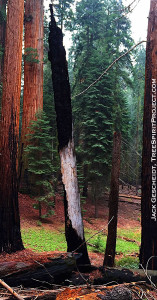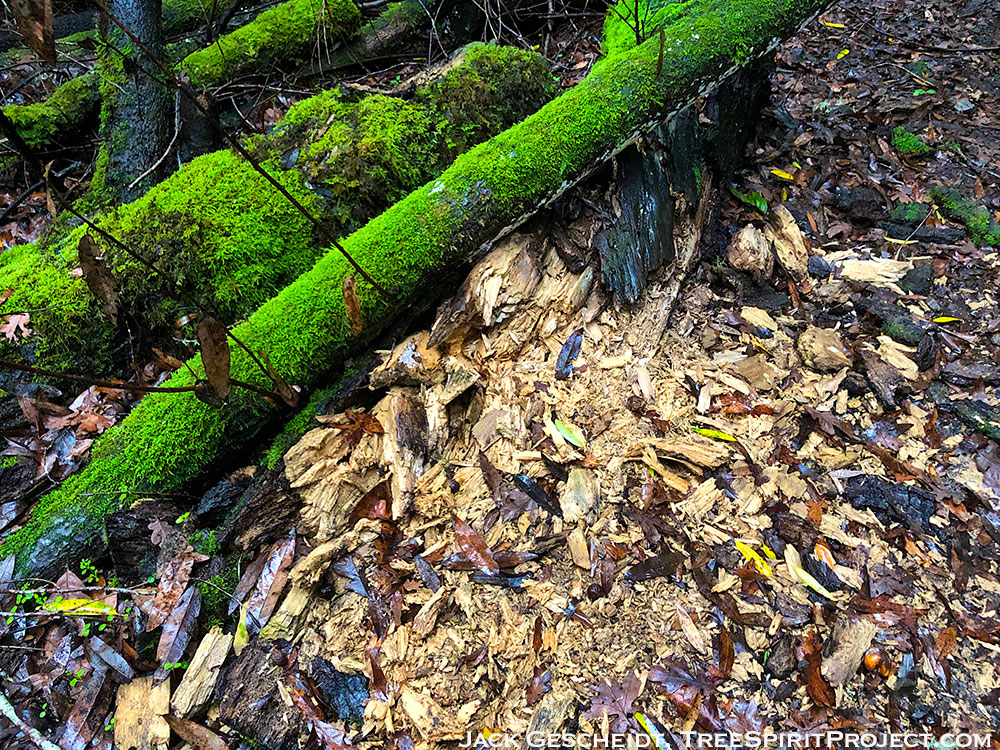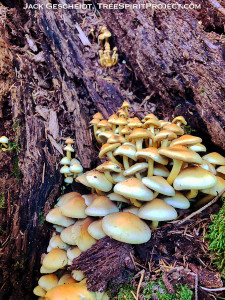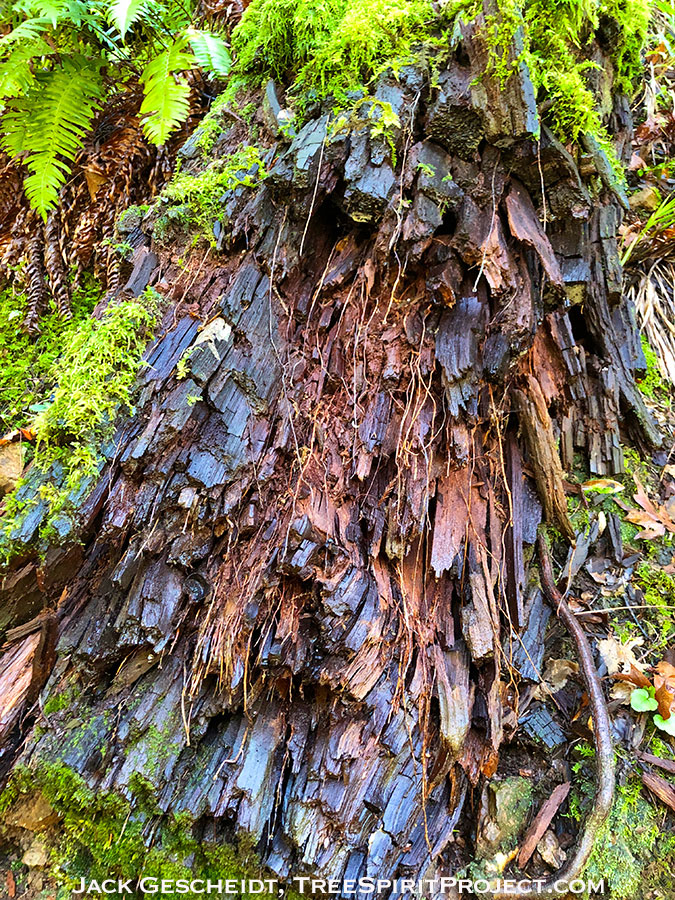Dead, dying, and decaying trees play an essential role increasing forest life.
Even tree lovers may not know the myriad ways trees some label “dying” or “sick” or “infected” or “infested” (with beetles or other insects) are in fact beneficial to a forest. Perhaps you’ve figured this out already, or know it intuitively, but forests do just fine without us humans interfering. Especially when our “helping” is driven by financial gain.
But fans of forest beware: timber companies hellbent on extracting more wood from U.S. and world forests have concocted yet another way of saying down is up, wrong is right, and denuding forests does a forest good. Their newest sell-off-the-forest pitch is to “remove” only “dead” or “dying” trees, to “clean up” or “manage” forests more “responsibly” implying this does no harm. Don’t believe it. All the quotations are used to indicate these terms are euphemisms which don’t convey the reality of how damage is done in “responsibly” “managing” a forest. This would actually entail leaving it alone, and certainly not bringing in heavy machinery.
Extracting “dead” or “down” or “dying” trees is only the latest insidious way of doing additional harm while ignoring the reality of our current situation: global warming is threatening humanity, which is caused in large part by decades of massive, and ongoing deforestation, nationally and globally. What we humans should instead be doing is leaving existing forests be, especially old-growth forests, not inflicting more damage or extractions of any kind. And planting more trees than we cut down — I mean, “harvest.” Important note: planting a sapling is NOT an equivalent replacement for cutting down a mature tree. Leave mature trees stand AND plant more trees. This would benefit us humans — as well as animals and plants and planet, because we’re actually all in this together. Deforestation for short term profit equals environmental and societal catastrophe in the long term.
The timber industry’s latest assaults begin ideologically. If they win over your mind, and public opinion, they will destroy our forests, and harm all of us in the end. In the public relations assault you’ll hear and read this lie: that forests benefit from industrial removal of “dead” or “dying” trees; that doing so has little or no impact on a forest’s health. Nothing could be further from the truth. Standing dead trees, and trees that have fallen over, and trees in any and every state of decay, are essential to the life cycles of decay and regeneration of a forest. And thus our health depends upon these, since we depend upon forests for carbon sequestration, oxygen production, soil creation, water filtration, wildlife habitat, and so much more.
Chad Hanson, Director of the John Muir Project, UC Davis researcher, and Sierra Club board member, says this about dead trees and forests:
We are trapped by an outdated cultural idea that a healthy forest is one with nothing but green trees. An ecologically healthy forest has dead trees, broken tops, and down logs. Such forests may not look tidy from the perception of a forester, but it (a forest with lots of dead trees) is the most biologically diverse and healthy, from a forest ecosystem perspective….Pound for pound, ton for ton, there is probably no more important habitat element in western conifer forests than large snags and large down logs.
The old practice of killing trees — what modern industry euphemistically calls “harvesting” — to make too many products that are either unnecessary or readily replaced with non-tree sources, has now become a suicidal practice. By killing trees and destroying forests everywhere, we are also killing ourselves, slowly, surely, and increasingly not so slowly.
Beware, too, other misleading, non-scientific labels like “invasive” and “non-native” which are also now commonly used to justify killing trees, plants, and animals, sometimes even by well-intentioned but tragically misled environmentalists. All have drunk the industrial agricultural public relations Kool-Aid. Meaning they kill wild plants and animals, imagining they are doing good, even justifying toxic herbicide use to do so. READ MORE: https://treespiritproject.com/Invasion Biology
Dead and decaying trees are precious to a forest. Here’s a short list of services they perform:
• DEAD TREES are wildlife habitat — homes! — for many species of insects, birds and mammals including beetles, bees, wasps, ants, mice, squirrels, salamanders, shrews, bats, rats, and wildcats (lynx, bobcat), raccoons, martens, and even cover for larger mammals including mountain lions and bears.
• DEAD TREES feed numerous fungi like mushrooms which in turn feed myriad animals, including rodents like voles.
• DEAD TREES provide crucial habitat (nesting, roosting and food storage) for many species of woodpeckers that rely solely upon them. Woodpeckers require dead wood that’s easier to penetrate than living wood. So woodpecker habitat is destroyed when timber companies extract dead trees, and forest health suffers as woodpecker services are diminished.
• DEAD TREES are food for insects which in turn feed larger animals including birds and mammals, all essential to forest health.
• DEAD TREES create new soil, a critical component from which all life springs
• DEAD TREES retain critical moisture in a forest as decomposing woody material
We must protect all remaining un-logged, or old-growth (over 200 years old) forests and leave intact any and all forests for their critical ecological service in our era of anthropogenic global warming. These include carbon sequestration (CO2 storage) as double duty; keeping the carbon in a living tree in its wood and out of the atmosphere, as well as allowing living trees to continue extracting additional CO2 from the atmosphere every day it is alive.
In addition to these obvious, rational-minded functions, now is also an ideal time for us planetary citizens to become more aware of the equally valuable emotional and spiritual tonic trees provide us. Notice and appreciate each individual tree growing near you, regardless of its species or its country of origin.
There are no “invasive” trees! You may have your favorites kinds of trees, but all provide critical ecological service. Maintain trees, care for them, plant more of them, and feel how they can reconnect us to the natural world we have for too long abandoned. If more of us do this more often, we just might be able to save our own species from dying too.
READ MORE ON THIS TOPIC:
Thanks to the always insightful George Wuerthner, Ecological Projects Director at the Foundation for Deep Ecology, for his article, “In Praise of Dead Trees,” which inspired this blog. Please read it for more trenchant observations on this subject: https://www.counterpunch.org/2018/12/24/in-praise-of-dead-trees






